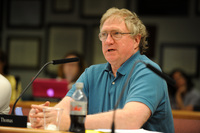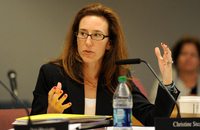Ann Arbor school leaders discuss fund equity 'magic number' to balance budget
How much of its approximately $18 million fund equity should Ann Arbor Public Schools use to balance its budget for Fiscal Year 2013?
That was the question school board members debated Wednesday, after rehashing the reductions needed to balance its $185.5 million budget and learning revenues were down again for this year’s third quarter, tacking on another $300,000 to the district’s $17.8 million deficit.

Andy Thomas
Allen estimated the fourth quarter could result in another $200,000 in lost revenue, bringing the district’s total budget deficit to $18.3 million. However, he specified this was a conservative estimate and may be high.
Allen said AAPS enacted a spending freeze at the end of the second quarter and pulled money from its savings account to cover the loss, when the financial report showed the district’s revenue projections were off by $1.8 million.
Board Secretary Andy Thomas said in 2009-10, “That was the year that everything hit the fan.” AAPS decided to implement mid-year cuts to make up for the lost revenue.
“After that, we made the appropriate decision we were not going to make any more massive changes to teachers or programs in the middle of the year. And we made the decision to use fund equity for revenue shortfalls,” Thomas said, adding in 2010-11, however, the district was able to use cuts in spending to cover its loss.
Allen said that is still a possibility for the current fiscal year. But if the district cannot recoup the estimated $2.3 million by July 1, the deficit will carry over into the new fiscal year.
There were no additional cuts proposed in the administration’s recommended budget Wednesday. It mirrored the $4.8 million in cuts that school board members said they would be likely to support during their May 16 Committee of the Whole meeting.
It also included using $7.05 million from the district’s fund balance and accounted for $6 million in revenue from Schools of Choice, Medicaid reimbursements and Gov. Rick Snyder’s Best Practices and proposed funds to offset teacher retirement costs.
The recommendation kept the closing of Roberto Clemente Student Development Center off the table as well as cuts to Ann Arbor Open’s busing. It was determined AAO’s routes could be reconfigured using a central hub for the same amount of savings ($98,800).
There were other possible pieces of good news for items still on the chopping block, both Allen and Thomas reported.
The board was amenable to eliminating the 4 p.m. bus routes for after-school programs at the middle schools. However, Thomas said the Ann Arbor Public Schools Educational Foundation might be willing to contribute to the busing or contribute to another area that could potentially help the district provide the service, but still reach the projected savings ($84,284).
Thomas also reported the Ann Arbor PTO Thrift Shop has offered to make a contribution and the University Bank, through its Kids B’Cause Fund, sent a check to the community foundation to provide scholarships for low-income students who wish to attend the district’s summer music camp at Interlochen. The board has voiced it would be OK with cutting the district’s $60,000 share toward funding that trip.
“What this illustrates is there is some willingness in the community to use private funding to help offset some of these cuts,” Thomas said. “I’d like us to not lose sight of that as we have these discussions.”
Although it was recommended funding for the middle school athletic directors be cut ($37,500), Allen said after speaking with the ADs and the building principals, the middle school administrators have asked to work on providing another option.

Christine Stead
Another positive, Allen said, is he’s “pretty confident” the district will receive a $1 million refund for money it over-contributed to its health insurance costs. He said this is because more employees are switching from the self-funded plan to one of the district’s rated plans, which saves the district money.
Vice President Christine Stead cautioned the board that using so much of the district’s fund equity this year could position Ann Arbor to have to borrow from the state — for the first time — to make payroll during the summer months of 2013-14.
“Once it’s gone, it’s gone,” Stead said of the district’s fund balance. “There is no way to grow that in this climate… So I would argue that our work on this budget is not done yet. We need to make more cuts for this year.”
President Deb Mexicotte explained that because the state and the schools’ annual fiscal years do not match up, districts’ fund allowance payments do not come in in time for schools to issue fall payroll. She said districts must either front the money from their fund equities or, for those districts operating in a deficit or in severe financial hardship, they must borrow money from the state until the state pays them their foundation allowance. The state also charges districts interest on these loans.

Deb Mexicotte
Thomas agreed, stating AAPS has reduced its fund balance at a rate of about $1.7 million per year.
“I would submit that is a very reasonable and very responsible and conservative way of addressing these deficits… I do not feel at all bad about using $7 million in fund equity this year,” he said. “But I would like us to be able to sit down in October, not April, and hear from administration this is the plan for eliminating another who knows what it'll be — between $14 million and $18 million — next year.
“The reason I feel it is important to have the conversation in October is… we don’t have that many bullets left in our gun.”
He said next year he genuinely sees the board considering: transportation as a whole, bargaining unit contracts, decreasing the number of teachers by a “drastic number” or closing schools and redistricting.
“All of these are going to require a great deal of thought and discussion and rolling them out to the community. …I don’t want to be caught in the same spot we are in this year.”
Thomas’ remarks received nods from around the table and Trustee Simone Lightfoot echoed his comments, saying she would support using $7 million from fund equity only if next year they “plan, plan, plan.”
“I’m to the point where I don’t want to touch new programs, new nothing,” she said. “I want to focus on how we stay above board with educating our students.”
Trustee Glenn Nelson added it may be time to consider another attempt at passing a countywide schools enhancement millage.
Staff reporter Danielle Arndt covers K-12 education for AnnArbor.com. Follow her on Twitter @DanielleArndt or email her at daniellearndt@annarbor.com.


Comments
dswan
Thu, May 24, 2012 : 5:14 p.m.
At the budget forum held on May 14 at Huron, the administration committed to posting the answers to questions posed by attendees by Friday, May 18, on the AAPS website. As of today, they are no where to be found. Status?
DonBee
Sat, May 26, 2012 : 12:57 a.m.
common_cents - Don't hold your breath. The administration breaks promises all the time.
jns131
Thu, May 24, 2012 : 2:43 p.m.
By closing Clemente and ending the busing out there you save more money then by slashing the choir/band fund money. I still say close Clemente, end busing there, send them to Stone School and slash Balais administration costs.
boo
Thu, May 24, 2012 : 1:04 p.m.
Groundhogs day? So, where do we cut? here are some ideas: 1. Get rid of all the alternative schools, and run them out of one of the wings at each of the three high schools. we have approximately 6000 high school students, so thats 2000 per school. It can be done. It will take strong leadership at each of the high schools. 2. Close two elementary schools. elementary schools can function fine with 350-400 kids, staffed well and supported with resources and strong teachers, save on the facility costs, administration, secretaries, other non teaching staff 3. Make transportation available to all kids - get kids to school safely and timely, stop this silly discussion over cutting transportation. 4. Stop talking about cutting sports and music, Get rid of Pay to Play - athletics is a huge part of the student experience, it's a community experience - get rid of pay to play so more kids can participate without hitting parents in the pocket. and music has been one of the shining lights of this district for decades. don't mess with the music program. 5. Pay your teachers the best salaries and evaluate the hell of out them. Get rid of poor teachers and reward the ones who do a great job educating our children. this goes for administrators too. Our problem isn't that we have highly paid teachers. Our problem is that even horrible teachers and principals are highly paid. I support Unions, but they need serious reform. 6. Stop with all the high cost consultants - you must have highly trained professionals within your teaching and principal ranks. why can't they provide professional development????? 7. the district may even consider going to schools of choice for high school to bring in more students (REVENUE), I know this isn't popular, but it's worth discussing.
jayjay
Thu, May 24, 2012 : 12:27 p.m.
I have shared this comment on other similar blogs, but it bears repeating. Take a look at the site, www.dflysolutions.com, and read about the energy efficiency program designed for K-12 schools. I have not seen it discussed anywhere as a possible improvement to AAPS budgets. Did someone at AAPS or on the school board investigate the site, look at what it might offer, and then talk to them. It not only talks about saving money through energy efficiency, but it also adds a new source of revenue, Environmental Certificates. I have not heard this in any discussions to date. Again, worth taking a look at? You be the judge, but if it offers opportunity, why are we not looking at it? Can we afford not to at least investigate it?
annarboral
Thu, May 24, 2012 : 12:13 p.m.
Absolutely none of the equity should be used this year. That should be a true "rainy day" fund. This isn't a surprse situation since it's been obvious for several years that AAPS needs to adjust to the present reality. In fact AAPS should be able to save money even now. True management ensures every dollar is well spent, not just spent. True management ensures that every dollar spent is effective, not just spent. The AAPS budget is rife with opportunities to save large sums of money but you need business types not liberal educators to run the AAPS business.
sh1
Thu, May 24, 2012 : 1:06 p.m.
If current times aren't "rainy days" with the state stripping schools of money at a rate many districts can't survive, what IS?
Dr. I. Emsayin
Thu, May 24, 2012 : 11:54 a.m.
There is a proposal to increase teacher funding of their retirements and for all retirees and current employees of the state-wide system to pay more for their health care benefits. If this goes through, the district will have a decrease in the amount they have to fund retirements, thus saving the district a big chunk of change for next year and future years. A county-wide millage could also help fund the districts locally. There is additional spending for personnel hired on softer money that could easily be cut. So much talk about cutting where it hurts in the schools but the budget is not completely transparent to taxpayers.